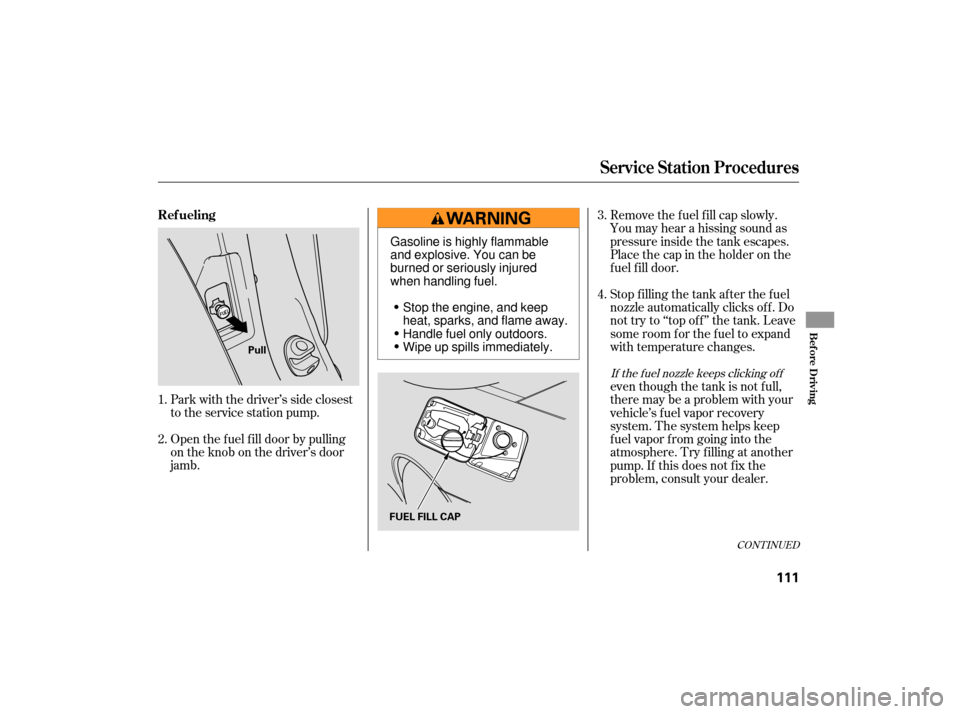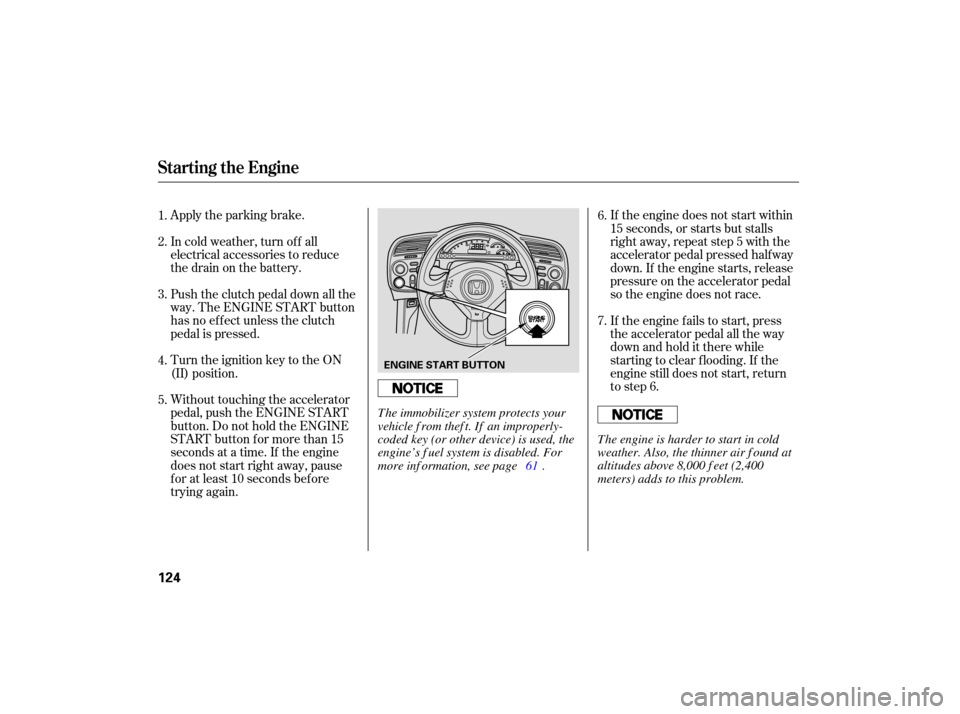Page 112 of 228
Bef ore you begin driving your
vehicle, you should know what
gasoline to use and how to check the
levels of important f luids. You also
need to know how to properly store
luggage or packages. The
inf ormation in this section will help
you. If you plan to add any
accessories to your vehicle, please
read the information in this section
first..............................
Break-in Period .110
.................
Fuel Recommendation . 110
.........
Service Station Procedures . 111
....................................
Ref ueling .111
OpeningandClosingthe .......................................
Hood .112
...................................
Oil Check .113
.............
Engine Coolant Check . 114
...............................
Fuel Economy .114
...
Accessories and Modif ications . 115
.............................
Carrying Cargo .117
Bef ore Driving
Bef ore Driving
109
Page 113 of 228

Help assure your vehicle’s f uture
reliability and perf ormance by paying
extra attention to how you drive
during the f irst 600 miles (1,000 km).
During this period:Avoid full-throttle starts and rapid
acceleration. Do not exceed 5,500
rpm f or the f irst 600 miles (1,000
km) of operation.
You should also f ollow these
recommendations with an
overhauled or exchanged engine, or
when the brakes are replaced. Avoidhardbrakingforthefirst
200 miles (300 km). Do not change the oil until the
scheduled maintenance time.
We recommend quality gasoline
containing detergent additives that
help prevent f uel system and engine
deposits.
In addition, in order to maintain good
perf ormance, f uel economy, and
emissions control, we strongly
recommend, in areas where it is
available, the use of gasoline that
does NOT contain manganese-based
f uel additives such as MMT.
Use of gasoline with these additives
may adversely af f ect perf ormance, and cause the malfunction indicator
lamp on your instrument panel to
come on. If this happens, contact
your authorized dealer f or service.
Some gasoline today is blended with
oxygenates such as ethanol or
MTBE. Your vehicle is designed to
operate on oxygenated gasoline
containing up to 10% ethanol by
volume and up to 15% MTBE by
volume. Do not use gasoline
containing methanol.
If you notice any undesirable
operating symptoms, try another
service station or switch to another
brand of gasoline.
For f urther important f uel-related
inf ormation, please ref er to your
.
Your vehicle is designed to operate
on premium unleaded gasoline with a
pump octane number of 91 or higher.
Useof aloweroctanegasolinecan
cause occasional metallic knocking
noises in the engine and will result in
decreased engine perf ormance. Use
of a gasoline with a pump octane
number less than 87 can lead to
engine damage.
Break-in Period
Fuel Recommendation
Quick Start Guide
Break-in Period, Fuel Recommendation
110
Page 114 of 228

Open the f uel f ill door by pulling
on the knob on the driver’s door
jamb. Park with the driver’s side closest
to the service station pump.Removethefuelfillcapslowly.
You may hear a hissing sound as
pressure inside the tank escapes.
Place the cap in the holder on the
fuel fill door.
Stop f illing the tank af ter the f uel
nozzle automatically clicks of f . Do
not try to ‘‘top off’’ the tank. Leave
some room f or the f uel to expand
with temperature changes.
even though the tank is not f ull,
there may be a problem with your
vehicle’s fuel vapor recovery
system. The system helps keep
f uel vapor f rom going into the
atmosphere. Try f illing at another
pump. If this does not f ix the
problem, consult your dealer.
1.
2. 3.
4.
CONT INUED
If the f uel nozzle keeps clicking of f
Ref ueling
Service Station Procedures
Bef ore Driving
111
Pull
FUEL FILL CAP
Gasoline is highly flammable
and explosive. You can be
burned or seriously injured
when handling fuel.Stop the engine, and keep
heat, sparks, and flame away.
Handle fuel only outdoors.
Wipe up spills immediately.
Page 116 of 228
Remove the dipstick again, and
ch eck the level. It should be
between the upper and lower
marks.
If it is near or below the lower mark,
see on page .
Wait a f ew minutes af ter turning the
engine of f bef ore you check the oil.
Remove the dipstick (black
handle).
Insert the dipstick all the way back
into its hole. Wipe of f the dipstick with a clean
cloth or paper towel.
To close the hood, lif t it up slightly to
remove the support rod f rom the
hole. Put the support rod back into
its holding clip. Lower the hood to
about a f oot (30 cm) above the
f ender, then let it drop. Make sure it
is securely latched. Holding the grip, pull the support
rod out of its clip. Insert the end
into the designated hole in the
hood.
3. 4.
1.
2.
3.
146
Service Station Procedures
A dding Engine Oil
Oil Check
Bef ore Driving
113
UPPER MARK
LOWER MARK
DIPSTICK
CLIP
SUPPORT ROD GRIP
Page 117 of 228

Try to maintain a constant speed.
Everytimeyouslowdownand
speed up, your vehic le uses extra
fuel. Use cruise control when
appropriate.
Combine several short trips into
one.
The air conditioning puts an extra
load on the engine which makes it
usemorefuel.Usethefresh-air
ventilation when possible.
Look at the coolant level in the
radiator reserve tank. Make sure it is
between the MAX and MIN lines. If
it is below the MIN line, see
on page for
info rmation on adding the proper
coolan t.
Refer to
on page for information
about checking other items on your
vehicle. Always
drive in the highest gear
possible. Drive moderately. Rapid
acceleration, abrupt cornering,
and hard braking use more fuel.
The
build-up of snow or mud on
your vehicl e’s underside adds
weight and rolling resistance.
Frequent cleaning helps your fuel
mileage and reduces the chance of
corrosion. an
underinflated tire
causes more ‘‘rolling resistance,’’
which uses more fuel.
Always
maintain your vehicle
according to the maintenance
messages displayed on the
information display. See
on page
.
149 141
141
For example,
Improving Fuel Economy
Fuel Economy
Engine Coolant Check
A dding
Engine Coolant
Owner’s Maintenance
Checks Owner’s
Maintenance Checks
Service Station Procedures, Fuel Economy
114
RESERVE TANK
MAX MIN
Page 124 of 228
This section gives you tips on
starting the engine under various
conditions, and how to operate the
manual transmission. It also includes
important inf ormation on parking
your vehicle and the braking system.........................
Driving Guidelines .122
........................
Preparing to Drive .123
.......................
Starting the Engine .124
...................
Manual Transmission . 125
...........................................
Parking .127
.............................
Braking System .127
...............
Anti-lock Brakes (ABS) . 128
Vehicle Stability Assist (VSA) ........................................
System .130
...........................
Towing a Trailer .131
Driving
Driving
121
Page 126 of 228
Youshoulddothefollowingchecks
and adjustmen ts before you drive
your vehicle.
Make sure all windows, mirrors,
and outside lights are clean and
unobstructed. Remove frost, snow,
or ice. Check
that any items you may be
carrying are stored properly or
fastened down securely. Fasten
your seat belt. Check that
your passenger has fastened his or
her seat belt (see page ).
When you start the engine, check
the gauges and indicato rs in the
instrument panel (see page ).
Check
the seat adjustment (see
page ).
Check the adjustment of the
inside and outside mirrors (see
page ).
Make sure the doors are securely
closed and locked.
Check that the hood is f ully closed.
Check that the trunk is f ully
closed.
Visually check the tires. If a tire
looks low, use a gauge to check its
pressure.
1.
2.
12
3.
4. 5.
6.
7.
8.
9.
10.
67
75 45
Preparing to Drive
Driving
123
Page 127 of 228

Apply the parking brake.
In cold weather, turn off all
electrical accessories to reduce
the drain on the battery.
Push the clutch pedal down all the
way. The ENGINE START button
has no effect unless the clutch
pedal is pressed.
Turn the ignition key to the ON
(II) position.
Without touching the accelerator
pedal, push the ENGINE START
button. Do not hold the ENGI NE
START button for more than 15
seconds at a time. If the engine
does not start right away, pause
for at least 10 seconds before
trying again. If
the engine fails to start, press
the accelerator pedal all the way
downandholdittherewhile
starting to clear flooding. If the
engine still does not start, return
to step 6.
Iftheenginedoesnotstartwithin
15
seconds, or starts but stalls
right away, repeat step 5 with the
accelerator pedal pressed halfway
down. If the engine starts, release
pressu re on the accelerator pedal
so the engine does not race.
1.
2.
3.
4.
5. 6.
7.
Starting
theEngine
124
ENGINE START BUTTON
The engine is harder to start in cold
weather. Also, the thinner air found at
altitudes above 8,000 feet (2,400
meters) adds to this problem.
The
immobilizer system protects your
vehicle f rom thef t. If an improperly-
coded key (or other device) is used, the
engine’s f uel system is disabled. For
more inf ormation, see page . 61